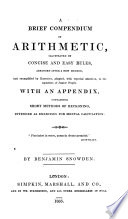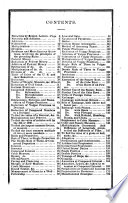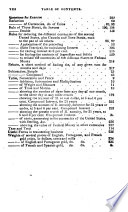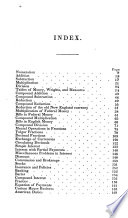 | Francis Walkingame - 1835 - 270 pages
...terms. An.-, (12) Reduce ^|J to its lowest terms. (13) Reduce i-ffJJJ to its lowest terms. RULE IV. To reduce fractions to a common denominator. Multiply...the denominators together for a common denominator. Or, When the less denominator of two fractions will divide the greater without a remainder : — Multiply... | |
 | Benjamin Snowden - 1835 - 108 pages
...ofTVF. Reduce i of i| of 9. F. Problem 10. — To reduce fractions to a common denominator. RULE. — Multiply each numerator into all the denominators...the denominators together for a common denominator. Reduce 1 1, -J- and % to a common denominator. 4 x 9 x 8 = 288 Ï 7x5x8 = 2fcO > New numerators. 3... | |
 | John Rose - Arithmetic - 1835 - 192 pages
...reduce fractions of different denominations to equivalent fractions having a common denominator. RULE. Multiply each numerator into all the denominators,...own, for a new numerator, and all the denominators into each other continually, for a common denominator. EXAMPLES. 1. Reduce J, f, and f, to equivalent... | |
 | Mathematics - 1836 - 488 pages
...different denominations may be reduced to a common denominator, by multiplying each numerator unto all the denominators except its own, for a new numerator...the denominators together, for a common denominator. To reduce an improper fraction to a mixed quantity, divide the numerator by the denominator. Fractions... | |
 | A. Turnbull - Arithmetic - 1836 - 368 pages
...fractions for addition and substraction. 323. The rule given in most Arithmetics is to multiply the numerator into all the denominators, except its own, for a new numerator, and all the denominators into themselves for a new denominator, and then to reduce the new fraction to its least terms. This... | |
 | Nathan Daboll - Arithmetic - 1837 - 262 pages
...equivalent fractions having a common denominator. RULE I. 1. Reduce all fractions to simple terms. 2. Multiply each numerator into all the denominators except its own, for a new numerator ; and all the denomif nators into each other continually for a common denominator ; this written under the several... | |
 | Benjamin Greenleaf - Arithmetic - 1839 - 356 pages
...the respective numerators of the fractions and their products will be the numerators required. Or, multiply each numerator into all the denominators...own for a new numerator; and all the denominators into each other for a common denominator. 2. Reduce |, |, I and &. / Ans. ||, $, |f, ?§. 3. Reduce... | |
 | Jason M. Mahan - Arithmetic - 1839 - 312 pages
...ff of jf^. to a aingb fraction. J-. CASE VI. t To reduce fractions to a common. denominator. RULE. Multiply each numerator into all the denominators,...own, for a new numerator; and all the denominators for a comman denominator. Examples. 1. Reduce \, |, $ and -*- to equivalent fractions, having a common... | |
 | Frederick Emerson - Arithmetic - 1839 - 300 pages
...have d.fferent denominators, to equivalent fractions, that shall have the same denominator. RULE 1st. Multiply each numerator into all the denominators except its own, for a new numerator. Then multiply all the denominators together for a new denominator, and place it under each new numerator.... | |
 | Thomas Grainger Hall - 1840 - 266 pages
..., 16x _ ^x_ _4л; íllu ~ ~' 33. To reduce fractions having different denominators to others having a common denominator, "Multiply each numerator into all the denominators except its own, for new numerators, and all die denominators together for a new denominator." The principle of the rule... | |
| |